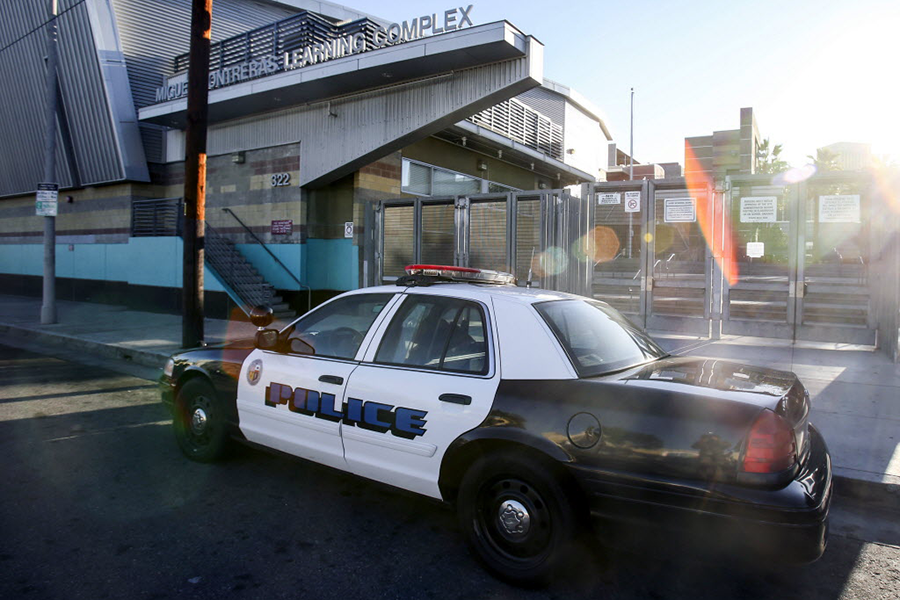Los Angeles bomb threat: Where to draw line between fear and caution?
Loading...
| New York
After a “credible” bomb threat prompted officials to shut down Los Angeles’s sprawling public school system Tuesday, Superintendent Ramon Cortines explained that he wasn’t going to take any chances.
Yet, on the other side of the country, officials in New York made a different decision when faced with the exact same bomb threat, keeping schools open.
By Tuesday afternoon, the threat had been dismissed as not credible. The electronic message referring to backpacks and “other packages” with bombs was traced to an address in Germany, and the Los Angeles Times, quoting law enforcement, reported that there was no sign that “this individual is actually capable of carrying out the threat.”
The different responses poignantly highlight a deeper question for Americans in a post-9/11 world: How should officials draw the line between excessive fear and practical caution?
In Los Angeles’s case, the answer seems to have been influenced heavily by the Dec. 2 terror attack in nearby San Bernardino, Calif. Call it the “Brussels effect.” In the week after the massive terror attack in Paris, Brussels shut down for four days amid an ongoing manhunt for one suspect.
Los Angeles’s decision is a reminder that similar disruptions to American cities' daily social and economic rhythms can be only a mouse-click away. Yet it also points to a calmer and more sanguine response to the threat of terror, with the city opening museums to students for free and keeping city parks open late.
As the nation continues to calibrate its responses to the ongoing threat of terrorism, Tuesday was a dramatic case study in how difficult every decision can be.
“A threatening e-mail ... sent from overseas, and 900 schools are closed. In the wake of the San Bernardino shootings could the L.A. school board afford not to act with caution? Probably not,” writes Danny Davis, a professor of homeland security at Texas A&M University in College Station, in an e-mail to the Monitor.
“But the ripples – economically, politically, socially – this threat is sending through southern California pose significant challenges to all levels of government policy makers.”
For his part, Superintendent Cortines, who is retiring in a matter of days, chose to act from an abundance of caution.
“The circumstances in the neighboring San Bernardino – I think what has happened in the nation, I think what happened internationally” was a factor in the decision to keep the city’s 640,000 public school students home, Cortines said. “I, as superintendent, am not going to take the chance with the life of students.”
By contrast, New York officials did not immediately view Tuesday’s threat as credible. New York Police Commissioner Bill Bratton even criticized the Los Angeles school closings, calling the move a “significant overreaction” made before consulting the Los Angeles Police Department.
“Based on the information that we have, this was a very generic piece of writing sent to a number of different places simultaneously and also written in a fashion that suggests that it’s not plausible, and we’ve come to the conclusion that we must continue to keep our school system open,” Mayor Bill de Blasio said. “In fact, it’s very important not to overreact in situations like this.”
Experts point out that the New York Police Department’s antiterrorism unit has become one of the most well-prepared in the world. It has even done its own international intelligence gathering.
But some say Los Angeles’s reaction, too, was understandable.
“I think what [Los Angeles officials] were doing was being cautious, going through the protocols,” says Tod Burke, a criminal justice at Radford University in Virginia. “And these are necessary, providing that it is indeed a credible threat – a law enforcement term, who must make the determination of what is credible.”
The issue of backpacks at schools is a real one, Professor Burke notes. To what extent can officials ensure public safety when they receive threats that someone may be carrying a backpack with a bomb, when practically everyone on campus has one?
“And so from a psychological standpoint, that’s exactly what terrorism is: It’s to provoke fear so that your operations stop,” he says.
The disruptions were felt by Los Angeles parents this morning, with many having to make quick arrangements to pick up their children, many of whom were already on the way to school. This then kept them from going to their jobs – a ripple effect with economic consequences, experts say.
“Families with kids were faced with a loud wake up call this morning, when the concept of terrorism actually affected their daily life,” says Carole Lieberman, a Hollywood-based psychiatrist and author of “Coping with Terrorism: Dreams Interrupted.” “No longer was it something they just had to hear about on the news – now they had to scramble to make alternative arrangements for their kids.”
But there were also signs of the city rallying to support a difficult decision.
And many of the children of the Los Angeles Unified School District, of course, didn’t mind at all.
“[O]ur son, who is a first-grader at an LAUSD elementary school, was so excited by the prospect of staying home for the day that he didn’t ask any questions,” wrote Los Angeles Times reporter Kerry Cavanaugh Tuesday. “He’s heard of snow days on the East Coast. I guess this is the modern-day equivalent of a snow day? A terror day?”
But Dr. Lieberman, out and about in Los Angeles Tuesday, says she understands the quick reactions by public school officials. They “are understandably very wary and on the lookout for the next attack,” she says. “But, to say they are ‘trigger happy’ may be overstating it, because it is better to be ready than complacent.”








